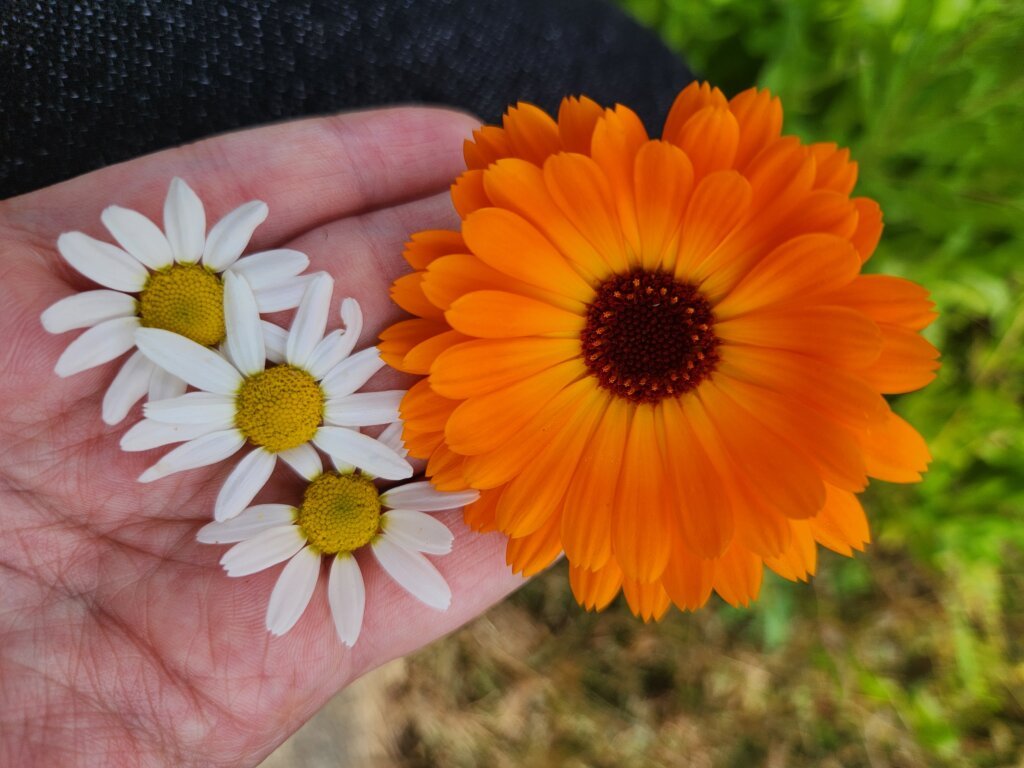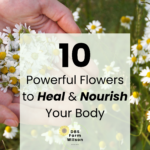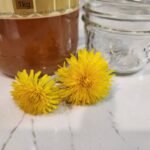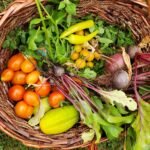Medicinal plants and natural home remedies is something that I want to learn more about as we slowly become more self-sufficient on our homestead. Relying on pharmaceuticals for every simple ailment – while they do have their place, is not what I want for my health or for my family’s health. The more we can use naturally occurring medicinal properties, the better our health should be.
In this season of life, I’m taking back my family’s health and diving into medicinal plant gardening and start building my own little apothecary. See everything I’ve already learned and medicinal remedies I’ve collected at my Medicinal Herb Hub.
With my own two littles at home, I know how overwhelming starting down a new path is. So here’s a list of 4 easy medicinal plants to start growing today and how to use them to build your own herbal apothecary.
This post contains affiliate links. If you use these links to buy something we may earn a commission. Thanks.
#1 Chamomile – The Comforting Healer

If you could only grow one medicinal herb, chamomile would be it. It’s cheerful, easy to grow, and packed with benefits.
- Why grow it: Chamomile tea helps with relaxation, digestion, and mild insomnia. It’s also gentle enough for children, pregnant women and breastfeeding mothers.
- How to grow: Choose Roman chamomile (a perennial) or German chamomile (an annual with more blooms). Plant in full sun and well-drained soil. Once it starts flowering, harvest the blossoms often to keep it producing.
- How to use it: Dry the flower heads for tea or make a soothing chamomile oil for skin irritation. You can also add a handful of blossoms to a warm bath for a relaxing soak.
- Full guide on how to Grow, Harvest and Use Chamomile.
Additionally, I’ll make some chamomile infused oil and use that to make a salve. Chamomile salves can be used topically to treat a wide array of ailments.
#2 Calendula – The Sunshine Healer

Calendula brightens up any garden with its orange and yellow flowers, but it’s more than just a pretty face – it’s a seriously medicinal plant.
- Why grow it: Calendula is known for its anti-inflammatory and skin-soothing properties. It’s perfect for minor cuts, bug bites, rashes, and dry skin. It works on large scar healing times (like c-sections for women), eczema and much more. Making it into a salve will help moisturize the skin while also healing from the oil.
- How to grow: Plant in full sun after the last frost. Calendula thrives in almost any soil and will self-seed for years if left to drop seeds.
- How to use it: Harvest petals and make an infused oil, then turn that oil into a homemade calendula salve for dry or irritated skin. The flower can also be consumed raw.
- Homestead tip: Bees and butterflies love calendula – it’s a win for your skin and your pollinators.
Between my chamomile and calendula salves we should have enough to treat many common external ailments. here’s how to make the salves.
#3 Ginger – Warming & Immune-Boosting
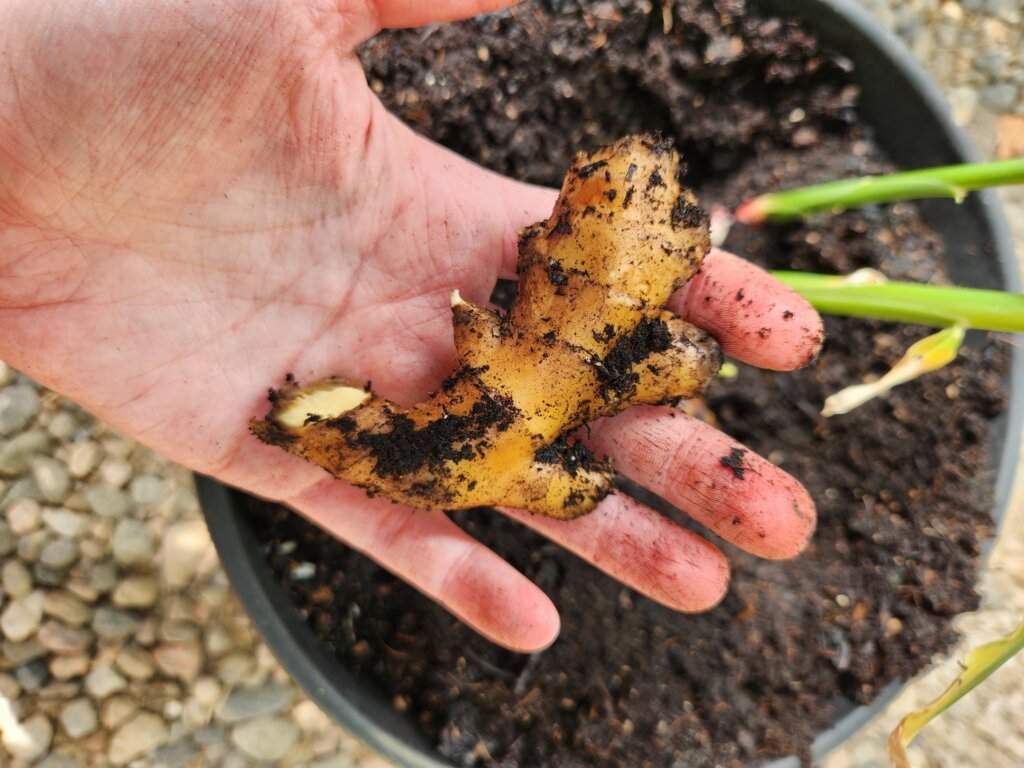
If you’ve only seen ginger in the grocery store, it’s time to try growing this medicinal plant yourself. It’s surprisingly simple, even in containers.
- Why grow it: Ginger supports digestion, helps with nausea, and fights cold and flu symptoms. Ginger is known for helping digestive track issues, such as nausea and bloating. It also has antioxidants which help the body treat infections – hence the benefits of ginger when you’re under the weather.
- Bonus: Add to your fire cider infusion recipe!
- How to grow: Plant a piece of ginger root (rhizome) in rich, moist soil in a warm location. If you live in a cooler climate, start it indoors or keep it in a sunny window.
- How to use it: Slice fresh ginger into tea, dry it for powder, or add to honey for a natural sore-throat remedy.

The Best Herbal Tea Combo: Ginger is known for it’s anti-inflammatory properties and it’s ability to fight colds and other viruses. Honey is well known to soothe sore throats, it’s also anti-viral and antimicrobial properties. Lemon is filled with Vitamin C. These ingredients combined make a fabulous tea to help ease your way back to health.
- Simple Process: Using a sterilized jar (I use mason jars with snap lid), fill it with cut up lemon pieces (any size you would like in your tea), finely chopped ginger and then fill with honey. Place in fridge to use over the next few weeks.
#4 Turmeric – The Golden Root of Health

Closely related to ginger, turmeric is another powerhouse medicinal plant for home medicine.
- Why grow it: It’s rich in curcumin, a natural anti-inflammatory compound known to support heart, joint, and brain health.
- Bonus: Add to your fire cider infusion recipe!
- How to grow: Plant turmeric rhizomes in warm soil with good drainage. It takes time to mature (about 8–10 months), so patience is key.
- How to use it: Harvest the roots, peel, and slice them. Use fresh turmeric in cooking or dry and grind for golden milk, teas, or natural dyes.
- We’ve been starting to use dried turmeric in our home cooking: ground beef seasoning, soups, rice and much more.
- Homestead tip: Even one potted plant can give you enough root for months of use.
Together, all these plants will help boost our health naturally.
How To Make Infused Oil
Infused oil is needed to make salve, it’s very easy to make! Once the flowers or leaves are cleaned, place them in an airtight container (such as these mason jars with snap lid) and fill the container with olive oil leaving one inch of oil covering. Let this sit and infuse in a pantry for 4-6 weeks. It will need to be shaken daily. After that time, strain out the plant material and there you have infused oil that can be used for anything. This method is used for any type of infused oil, rosemary herb infused oil, basil herb infused oil, etc.

How to Make Salve
This is the fun step. With the infused oil made from above, add one cup of infused oil to 3-4 tablespoons for beeswax and melt into a double broiler. Once the mixture is in a liquid form, pour it into salve tin containers and it will quickly solidify. That’s it!
Beeswax is a lot easier to come by than you would think. You can buy beeswax pellets on Amazon. It’s recommended to use the beeswax pellets because it’s easier to portion out your mixture and add more pellets as needed if you want your salve thicker.
I’m going to ask our local honey farm if they have any beeswax they want to part with. I would always recommend this method first. It’s healthier and you’re assisting a local small business as opposed to the Amazon conglomerate.
Lastly is getting the salve tins. I would just suggest getting from Amazon too as it’s the easiest place to find them in the biggest quantity.
FAQ: Growing and Using Medicinal Plants
Absolutely. Chamomile, calendula, ginger, and turmeric all grow well in pots – perfect for patios or small spaces.
For most plants, harvest in the morning after the dew dries but before the sun gets too hot. Flowers like chamomile and calendula are most potent when freshly opened.
Hang them upside down in a dark, dry space with good air circulation. Once crisp, store in glass jars away from light and heat.
Yes – but the flavor and strength will be lighter. Dried herbs make a stronger, more shelf-stable tea blend.
Why Go Homeopathic?
These four herbs – chamomile, calendula, ginger, and turmeric – are the foundation of any home apothecary. They’re simple to grow, beautiful to look at, and endlessly useful.
There’s absolutely no harm in consuming it, so why not add it in your daily diet. Same principle with the salves. Using a lotion that you created all by yourself to help ease skin ailments (when the ones from the store have those exact ingredients on them), will save you money while also taking back your own health. Instead of using whatever toxic ingredients are in bug-bite sprays, try using a home-remedy.
Whether you’re starting a small medicinal garden by your kitchen door or filling your raised beds with healing blooms, these plants will serve you well season after season.
Next step: Start with one or two plants this year. Take notes, experiment, and enjoy the process. You’ll be amazed how quickly your garden begins to double as your medicine cabinet.
We also have plenty of growing guides, seed saving guides and recipes. We are growing our website with more articles all the time, and we invite you to grow with us – join our newsletter for seasonal reminders and garden tips straight to your inbox!. If you have any questions about these medicinal plants or would like to share some of your knowledge with us please leave a comment below. Happy Gardening!

